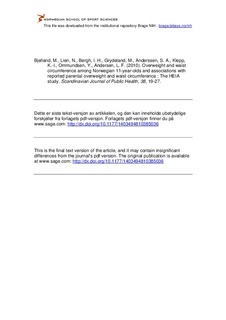| dc.contributor.author | Bjelland, Mona | |
| dc.contributor.author | Lien, Nanna | |
| dc.contributor.author | Bergh, Ingunn Holden | |
| dc.contributor.author | Grydeland, May | |
| dc.contributor.author | Anderssen, Sigmund A. | |
| dc.contributor.author | Klepp, Knut-Inge | |
| dc.contributor.author | Ommundsen, Yngvar | |
| dc.contributor.author | Andersen, Lene F. | |
| dc.date.accessioned | 2011-11-02T09:27:49Z | |
| dc.date.available | 2011-11-02T09:27:49Z | |
| dc.date.issued | 2010-11 | |
| dc.identifier | Seksjon for coaching og psykologi / Department of Coaching and Psychology | |
| dc.identifier.citation | Scandinavian Journal of Public Health. 2010, 38(Suppl. 5), 19-27 | no_NO |
| dc.identifier.issn | 1651-1905 | |
| dc.identifier.issn | 1403-4948 | |
| dc.identifier.uri | http://hdl.handle.net/11250/170699 | |
| dc.description | I Brage finner du siste tekst-versjon av artikkelen, og den kan inneholde ubetydelige forskjeller fra forlagets pdf-versjon. Forlagets pdf-versjon finner du på www.sage.com: http://dx.doi.org/10.1177/1403494810385036 / In Brage you'll find the final text version of the article, and it may contain insignificant differences from the journal's pdf version. The original publication is available at www.sage.com: http://dx.doi.org/10.1177/1403494810385036 | no_NO |
| dc.description.abstract | Aims: The aim of this paper is to investigate anthropometric characteristics in 11-year-old Norwegian by gender and parental
education, and to study associations between adolescents’ overweight and waist circumference (WC) and maternal and
paternal overweight and WC. Methods: A total of 1483 adolescents, 1156 mothers, and 1016 fathers participated in the
baseline survey of the HEalth In Adolescents (HEIA) study (September 2007). Anthropometric measures of the adolescents
were assessed by project staff according to standard procedures. Self-reported data about pubertal status were collected
through questionnaires. Parental education and anthropometric measures of parents were collected by self-report. Results:
The prevalence of overweight (including obesity) determined by the cut-offs for body mass index (BMI) suggested by the
International Obesity Task Force was 14.6% among girls and 13.6% among boys. The highest prevalence of overweight was
observed among adolescents with parents who had less than 12 years of education (18.8%). Overweight and WC in girls was
strongly associated with maternal overweight and WC. For boys, overweight and WC was strongly associated with both
maternal and paternal overweight and WC. Conclusions: There was a social gradient in anthropometric characteristics
and overweight rates among Norwegian 11-year-old adolescents. Maternal overweight and WC was
associated with overweight and WC in girls and boys, while paternal overweight and WC were associated with
overweight andWCin boys. The results indicate that mothers are key persons in prevention of overweight among
adolescents, despite gender. Fathers are important as role models for their sons. Targeting parental overweight/
obesity could be a strategy in future interventions. | no_NO |
| dc.language.iso | eng | no_NO |
| dc.publisher | SAGE | no_NO |
| dc.subject | adolescent | no_NO |
| dc.subject | anthropometric measures | no_NO |
| dc.subject | body mass index | no_NO |
| dc.subject | cross-sectional | no_NO |
| dc.subject | obesity | no_NO |
| dc.subject | overweight | no_NO |
| dc.subject | parents | no_NO |
| dc.subject | prevalence | no_NO |
| dc.subject | socioeconomic status | no_NO |
| dc.subject | waist circumference | no_NO |
| dc.title | Overweight and waist circumference among Norwegian 11-year-olds and associations with reported parental overweight and waist circumference : the HEIA study | no_NO |
| dc.type | Journal article | no_NO |
| dc.type | Peer reviewed | no_NO |
| dc.subject.nsi | VDP::Medical disciplines: 700 | no_NO |
| dc.source.pagenumber | 19-27 | no_NO |
| dc.source.volume | 38 | no_NO |
| dc.source.journal | Scandinavian Journal of Public Health | no_NO |
| dc.source.issue | Suppl. 5 | no_NO |
